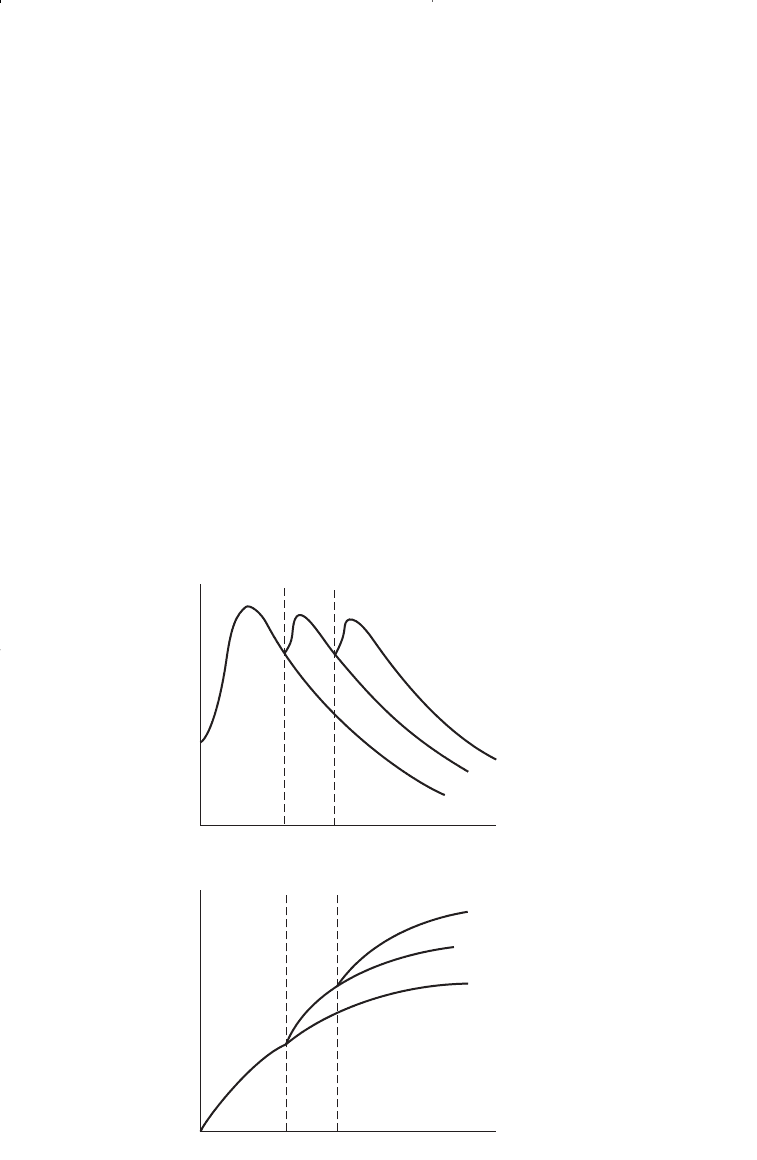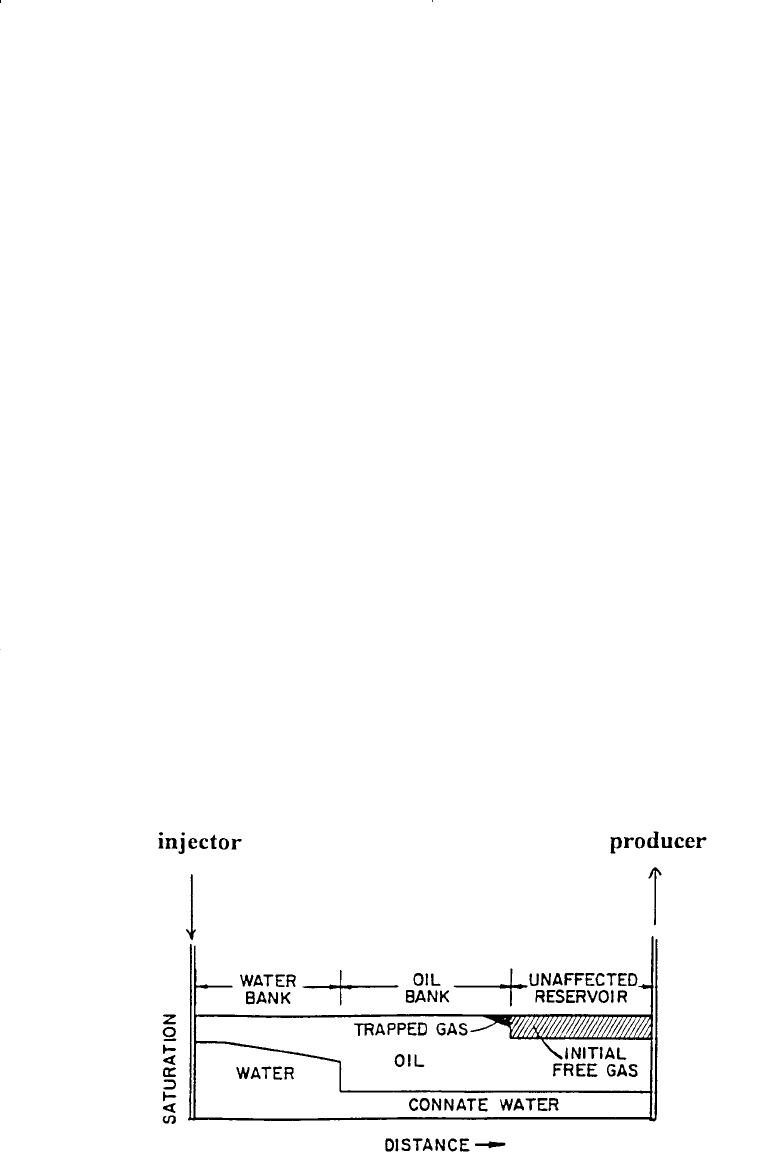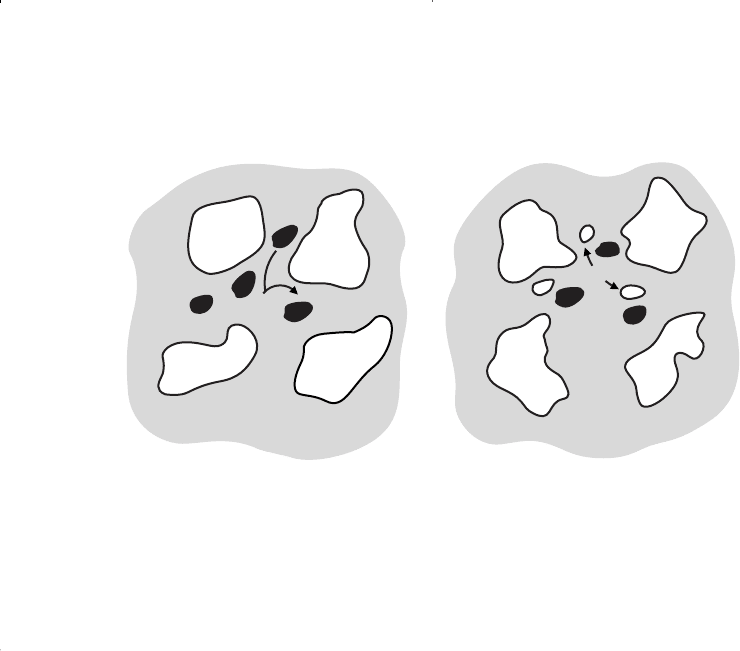Tarek Ahmed. Reservoir engineering handbook
Подождите немного. Документ загружается.


designed to recover oil, commonly described as residual oil, left in the
reservoir after both primary and secondary recovery methods have been
exploited to their respective economic limits. Figure 14-1 illustrates the
concept of the three oil recovery categories.
FACTORS TO CONSIDER IN WATERFLOODING
Thomas, Mahoney, and Winter (1989) pointed out that in determining
the suitability of a candidate reservoir for waterflooding, the following
reservoir characteristics must be considered:
• Reservoir geometry
• Fluid properties
• Reservoir depth
• Lithology and rock properties
• Fluid saturations
858 Reservoir Engineering Handbook
Overall Recovery
Time
Primary
Secondary
Tertiary
Field Flow Rate
Time
Primary
Secondary
Tertiary
Figure 14-1. Oil recovery categories.
Reservoir Eng Hndbk Ch 14 2001-10-25 17:37 Page 858

• Reservoir uniformity and pay continuity
• Primary reservoir driving mechanisms
Each of these topics is discussed in detail in the following subsections.
Reservoir Geometry
The areal geometry of the reservoir will influence the location of wells
and, if offshore, will influence the location and number of platforms
required. The reservoir’s geometry will essentially dictate the methods by
which a reservoir can be produced through water-injection practices.
An analysis of reservoir geometry and past reservoir performance is
often important when defining the presence and strength of a natural
water drive and, thus, when defining the need to supplement the natural
injection. If a water-drive reservoir is classified as an active water drive,
injection may be unnecessary.
Fluid Properties
The physical properties of the reservoir fluids have pronounced effects
on the suitability of a given reservoir for further development by water-
flooding. The viscosity of the crude oil is considered the most important
fluid property that affects the degree of success of a waterflooding proj-
ect. The oil viscosity has the important effect of determining the mobility
ratio that, in turn, controls the sweep efficiency.
Reservoir Depth
Reservoir depth has an important influence on both the technical and
economic aspects of a secondary or tertiary recovery project. Maximum
injection pressure will increase with depth. The costs of lifting oil from
very deep wells will limit the maximum economic water–oil ratios that
can be tolerated, thereby reducing the ultimate recovery factor and
increasing the total project operating costs. On the other hand, a shallow
reservoir imposes a restraint on the injection pressure that can be used,
because this must be less than fracture pressure. In waterflood operations,
there is a critical pressure (approximately 1 psi/ft of depth) that, if exceed-
ed, permits the injecting water to expand openings along fractures or to
create fractures. This results in the channeling of the injected water or the
bypassing of large portions of the reservoir matrix. Consequently, an oper-
ational pressure gradient of 0.75 psi/ft of depth normally is allowed to
provide a sufficient margin of safety to prevent pressure parting.
Principles of Waterflooding 859
Reservoir Eng Hndbk Ch 14 2001-10-25 17:37 Page 859

Lithology and Rock Properties
Thomas et al. (1989) pointed out that lithology has a profound influ-
ence on the efficiency of water injection in a particular reservoir. Reser-
voir lithology and rock properties that affect flood ability and success
are:
• Porosity
• Permeability
• Clay content
• Net thickness
In some complex reservoir systems, only a small portion of the total
porosity, such as fracture porosity, will have sufficient permeability to be
effective in water-injection operations. In these cases, a water-injection
program will have only a minor impact on the matrix porosity, which
might be crystalline, granular, or vugular in nature.
Although evidence suggests that the clay minerals present in some
sands may clog the pores by swelling and deflocculating when water-
flooding is used, no exact data are available as to the extent to which this
may occur.
Tight (low-permeability) reservoirs or reservoirs with thin net thick-
ness possess water-injection problems in terms of the desired water-
injection rate or pressure. Note that the water-injection rate and pressure
are roughly related by the following expression:
where p
inj
= water-injection pressure
i
w
= water-injection rate
h = net thickness
k = absolute permeability
The above relationship suggests that to deliver a desired daily injection
rate of i
w
in a tight or thin reservoir, the required injection pressure might
exceed the formation fracture pressure.
p
i
hk
inj
w
∝
860 Reservoir Engineering Handbook
Reservoir Eng Hndbk Ch 14 2001-10-25 17:37 Page 860

Fluid Saturations
In determining the suitability of a reservoir for waterflooding, a high
oil saturation that provides a sufficient supply of recoverable oil is the
primary criterion for successful flooding operations. Note that higher oil
saturation at the beginning of flood operations increases the oil mobility
that, in turn, gives higher recovery efficiency.
Reservoir Uniformity and Pay Continuity
Substantial reservoir uniformity is one of the major physical criterions
for successful waterflooding. For example, if the formation contains a
stratum of limited thickness with a very high permeability (i.e., thief
zone), rapid channeling and bypassing will develop. Unless this zone can
be located and shut off, the producing water–oil ratios will soon become
too high for the flooding operation to be considered profitable.
The lower depletion pressure that may exist in the highly permeable
zones will also aggravate the water-channeling tendency due to the high-
permeability variations. Moreover, these thief zones will contain less
residual oil than the other layers, and their flooding will lead to relatively
lower oil recoveries than other layers.
Areal continuity of the pay zone is also a prerequisite for a successful
waterflooding project. Isolated lenses may be effectively depleted by a
single well completion, but a flood mechanism requires that both the
injector and producer be present in the lens. Breaks in pay continuity and
reservoir anisotropy caused by depositional conditions, fractures, or
faulting need to be identified and described before determining the prop-
er well spanning and the suitable flood pattern orientation.
Primary Reservoir Driving Mechanisms
As described in Chapter 11, six driving mechanisms basically provide
the natural energy necessary for oil recovery:
• Rock and liquid expansion
• Solution gas drive
• Gas cap drive
• Water drive
• Gravity drainage drive
• Combination drive
Principles of Waterflooding 861
Reservoir Eng Hndbk Ch 14 2001-10-25 17:37 Page 861

The recovery of oil by any of the above driving mechanisms is called
primary recovery. The term refers to the production of hydrocarbons
from a reservoir without the use of any process (such as water injection)
to supplement the natural energy of the reservoir. The primary drive
mechanism and anticipated ultimate oil recovery should be considered
when reviewing possible waterflood prospects. The approximate oil
recovery range is tabulated below for various driving mechanisms. Note
that these calculations are approximate and, therefore, oil recovery may
fall outside these ranges.
Driving Mechanism Oil Recovery Range, %
Rock and liquid expansion 3–7
Solution gap 5–30
Gas cap 20–40
Water drive 35–75
Gravity drainage <80
Combination drive 30–60
Water-drive reservoirs that are classified as strong water-drive reser-
voirs are not usually considered to be good candidates for waterflooding
because of the natural ongoing water influx. However, in some instances
a natural water drive could be supplemented by water injection in order
to:
• Support a higher withdrawal rate
• Better distribute the water volume to different areas of the field to
achieve more uniform areal coverage
• Better balance voidage and influx volumes.
Gas-cap reservoirs are not normally good waterflood prospects
because the primary mechanism may be quite efficient without water
injection. In these cases, gas injection may be considered in order to help
maintain pressure. Smaller gas-cap drives may be considered as water-
flood prospects, but the existence of the gas cap will require greater care
to prevent migration of displaced oil into the gas cap. This migration
would result in a loss of recoverable oil due to the establishment of resid-
ual oil saturation in pore volume, which previously had none. If a gas cap
is repressured with water, a substantial volume may be required for this
purpose, thereby lengthening the project life and requiring a higher vol-
862 Reservoir Engineering Handbook
Reservoir Eng Hndbk Ch 14 2001-10-25 17:37 Page 862

ume of water. However, the presence of a gas cap does not always mean
that an effective gas-cap drive is functioning. If the vertical communica-
tion between the gas cap and the oil zone is considered poor due to low
vertical permeability, a waterflood may be appropriate in this case.
Analysis of past performance, together with reservoir geology studies,
can provide insight as to the degree of effective communication. Natural
permeability barriers can often restrict the migration of fluids to the gas
cap. It may also be possible to use selective plugging of input wells to
restrict the loss of injection fluid to the gas cap.
Solution gas-drive mechanisms generally are considered the best candi-
dates for waterfloods. Because the primary recovery will usually be low, the
potential exists for substantial additional recovery by water injection. In
effect, we hope to create an artificial water-drive mechanism. The typical
range of water-drive recovery is approximately double that of solution gas
drive. As a general guideline, waterfloods in solution gas-drive reservoirs fre-
quently will recover an additional amount of oil equal to primary recovery.
Volumetric undersaturated oil reservoirs producing above the bubble-
point pressure must depend on rock and liquid expansion as the main driving
mechanism. In most cases, this mechanism will not recover more than about
5% of the original oil in place. These reservoirs will offer an opportunity for
greatly increasing recoverable reserves if other conditions are favorable.
OPTIMUM TIME TO WATERFLOOD
The most common procedure for determining the optimum time to
start waterflooding is to calculate:
• Anticipated oil recovery
• Fluid production rates
• Monetary investment
• Availability and quality of the water supply
• Costs of water treatment and pumping equipment
• Costs of maintenance and operation of the water installation facilities
• Costs of drilling new injection wells or converting existing production
wells into injectors
These calculations should be performed for several assumed times and
the net income for each case determined. The scenario that maximizes
the profit and perhaps meets the operator’s desirable goal is selected.
Principles of Waterflooding 863
Reservoir Eng Hndbk Ch 14 2001-10-25 17:37 Page 863

Cole (1969) lists the following factors as being important when determin-
ing the reservoir pressure (or time) to initiate a secondary recovery project:
• Reservoir oil viscosity. Water injection should be initiated when the
reservoir pressure reaches its bubble-point pressure since the oil vis-
cosity reaches its minimum value at this pressure. The mobility of the
oil will increase with decreasing oil viscosity, which in turns improves
the sweeping efficiency.
• Free gas saturation. (1) In water injection projects. It is desirable to
have initial gas saturation, possibly as much as 10%. This will occur at
a pressure that is below the bubble point pressure. (2) In gas injection
projects. Zero gas saturation in the oil zone is desired. This occurs
while reservoir pressure is at or above bubble-point pressure.
• Cost of injection equipment. This is related to reservoir pressure, and
at higher pressures, the cost of injection equipment increases. There-
fore, a low reservoir pressure at initiation of injection is desirable.
• Productivity of producing wells. A high reservoir pressure is desirable
to increase the productivity of producing wells, which prolongs the
flowing period of the wells, decreases lifting costs, and may shorten
the overall life of the project.
• Effect of delaying investment on the time value of money. A delayed
investment in injection facilities is desirable from this standpoint.
• Overall life of the reservoir. Because operating expenses are an impor-
tant part of total costs, the fluid injection process should be started as
early as possible.
Some of these six factors act in opposition to others. Thus the actual
pressure at which a fluid injection project should be initiated will require
optimization of the various factors in order to develop the most favorable
overall economics.
The principal requirement for a successful fluid injection project is that
sufficient oil must remain in the reservoir after primary operations have
ceased to render economic the secondary recovery operations. This high
residual oil saturation after primary recovery is essential not only because
there must be a sufficient volume of oil left in the reservoir, but also because
of relative permeability considerations. A high oil relative permeability, i.e.,
high oil saturation, means more oil recovery with less production of the dis-
placing fluid. On the other hand, low oil saturation means a low oil relative
permeability with more production of the displacing fluid at a given time.
864 Reservoir Engineering Handbook
Reservoir Eng Hndbk Ch 14 2001-10-25 17:37 Page 864

EFFECT OF TRAPPED GAS ON WATERFLOOD
RECOVERY
Numerous experimental and field studies have been conducted to
study the effect of the presence of initial gas saturation on waterflood
recovery. Early research indicated that the waterflooding of a linear sys-
tem results in the formation of an oil bank, or zone of increased oil satu-
ration, ahead of the injection water. The moving oil bank will displace a
portion of the free water ahead of it, trapping the rest as a residual gas.
An illustration of the water saturation profile is shown schematically in
Figure 14-2. Several authors have shown through experiments that oil
recovery by water is improved as a result of the establishment of
trapped gas saturation, S
gt
, in the reservoir.
The theory of this phenomenon of improving overall oil recovery
when initial gas exists at the start of the flood is not well established;
however, Cole (1969) proposed the following two different theories that
perhaps provide insight to this phenomenon.
First Theory
Cole (1969) postulates that since the interfacial tension of a gas–oil
system is less than the interfacial tension of a gas–water system, in a
three-phase system containing gas, water, and oil, the reservoir fluids
will tend to arrange themselves in a minimum energy relationship. In this
Principles of Waterflooding 865
Figure 14-2. Water saturation profile during a waterflood.
Reservoir Eng Hndbk Ch 14 2001-10-25 17:37 Page 865

case, this would dictate that the gas molecules enclose themselves in an
oil “blanket.” This increases the effective size of any oil globules, which
have enclosed some gas. When the oil is displaced by water, the oil glob-
ules are reduced to some size dictated by the flow mechanics. If a gas
bubble existed on the inside of the oil globule, the amount of residual oil
left in the reservoir would be reduced by the size of the gas bubble within
the oil globule. As illustrated in Figure 14-3, the external diameters of the
residual oil globules are the same in both views. However, in view b, the
center of the residual oil globule is not oil, but gas. Therefore, in view b,
the actual residual oil saturation is reduced by the size of the gas bubble
within the oil globule.
Second Theory
Cole (1969) points out that reports on other laboratory experiments
have noted the increased recovery obtained by flooding cores with air
after waterflooding. These cores were classified as water-wet at the time
the laboratory experiments were conducted. On the basis of these experi-
ments, it was postulated that the residual oil saturation was located in the
larger pore spaces, since the water would be preferentially pulled into the
smaller pore spaces by capillary action in the water-wet sandstone. At a
later time, when air was flooded through the core, it moved preferentially
866 Reservoir Engineering Handbook
Rock
Grains
Residual Oil Globules
Residual Oil Globules
With Freegas Phase Inside The Oil
Water
(a) (b)
Rock
Grains
Figure 14-3. Effect of free gas saturation on S
or
(first theory). (After Cole, F., 1969.)
Reservoir Eng Hndbk Ch 14 2001-10-25 17:37 Page 866

through the larger pore spaces since it was nonwetting. However, in pass-
ing through these large pore spaces, the air displaced some of the residual
oil left by water displacement.
This latter theory is more nearly compatible with fluid flow observa-
tions, because the gas saturation does not have to exist inside the oil
phase. If this theory were correct, the increased recovery due to the
presence of free gas saturation could be explained quite simply for
water-wet porous media. As the gas saturation formed, it displaced oil
from the larger pore spaces, because it is more nonwetting to the reser-
voir rock than the oil. Then, as water displaced the oil from the reservoir
rock, the amount of residual oil left in the larger pore spaces would be
reduced because of occupancy of a portion of this space by gas. This
phenomenon is illustrated in Figure 14-4. In view a, there is no free gas
saturation and the residual oil occupies the larger pore spaces. In view b,
free gas saturation is present and this free gas now occupies a portion of
the space originally occupied by the oil. The combined residual satura-
tions of oil and gas in view b are approximately equal to the residual oil
saturation of view a.
Craig (1971) presented two graphical correlations that are designed to
account for the reduction in the residual oil saturation due to the presence
of the trapped gas. The first graphical correlation, shown in Figure 14-5,
correlates the trapped gas saturation (S
gt
) as a function of the initial
gas saturation (S
gi
). The second correlation as presented in Figure 14-6
Principles of Waterflooding 867
Sand
Grain
(a) (b)
Water
Gas
Oil
Figure 14-4. Effect of free gas saturation on S
or
(second theory). (After Cole, F., 1969.)
Reservoir Eng Hndbk Ch 14 2001-10-25 17:37 Page 867
